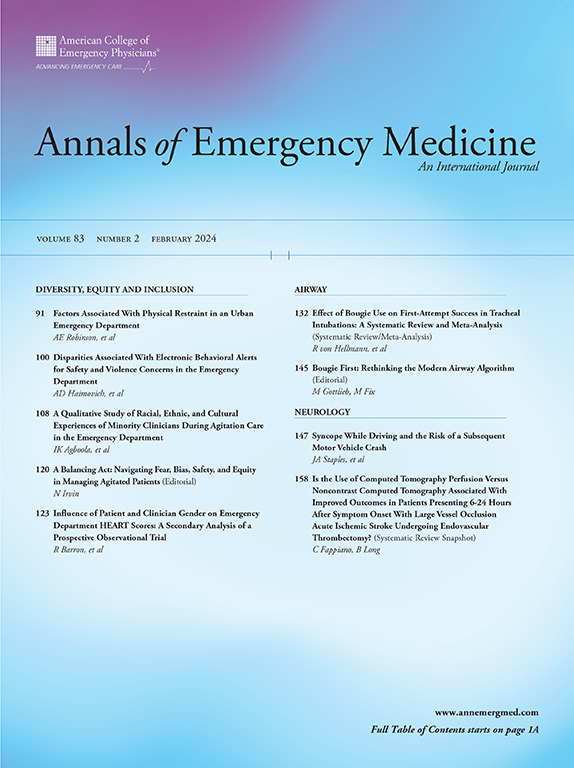临床路径修订增加了阿莫西林单药治疗和5天治疗时间在急诊科和急诊儿科社区获得性肺炎:质量改进倡议。
IF 5
1区 医学
Q1 EMERGENCY MEDICINE
引用次数: 0
摘要
研究目的:美国儿科学会推荐5天阿莫西林单药治疗作为儿科无并发症社区获得性肺炎的一线治疗。我们的目标是使用地方质量改善干预措施来增加一线阿莫西林的使用,减少阿奇霉素的使用,并增加无并发症社区获得性肺炎的5天治疗时间。方法在包括4个急诊科(ed)和5个急诊中心在内的儿科医院网络开展质量改进活动。纳入了2018年7月至2022年7月期间诊断为社区获得性肺炎并开了抗生素的出院儿童。实施了两部分干预:(1)预选5天抗生素治疗的电子健康记录订单集(2020年8月)和(2)新纳入电子健康记录的修订社区获得性肺炎途径(2021年4月)。使用统计过程控制图分析阿莫西林、阿奇霉素和抗生素持续时间不超过5天的抗生素接触比例,以确定特殊原因变化。结果顺序集的实施对儿童社区获得性肺炎处方无影响。途径修正后,阿莫西林处方率从60.6%上升到70.9%,阿奇霉素处方率从12.5%下降到3.7%,5天及以下用药时间从2.0%上升到66.1%。结论:修订后的电子健康记录整合社区获得性肺炎途径可提高对指南推荐抗生素选择的高度依从性,并减少急诊科和急诊儿科社区获得性肺炎的抗生素持续时间。地方质量改进工作在适应机构工作流程和文化的情况下,可以有效地实施临床途径,支持在不同的卫生保健环境中为简单的社区获得性肺炎开具循证处方。本文章由计算机程序翻译,如有差异,请以英文原文为准。
Clinical Pathway Revision Increases Amoxicillin Monotherapy and 5-Day Durations of Therapy for Pediatric Community-Acquired Pneumonia in the Emergency Department and Urgent Care: A Quality Improvement Initiative.
STUDY OBJECTIVE
The American Academy of Pediatrics recommends 5-day amoxicillin monotherapy as first-line treatment for pediatric uncomplicated community-acquired pneumonia. We aimed to use local quality improvement interventions to increase first-line amoxicillin use, reduce azithromycin use, and increase 5-day therapy durations for uncomplicated community-acquired pneumonia.
METHODS
A quality improvement initiative took place at a pediatric hospital network, including 4 emergency departments (EDs) and 5 urgent care centers. Children discharged between July 2018 and July 2022 with a community-acquired pneumonia diagnosis and an antibiotic prescribed were included. A 2-part intervention was implemented: (1) an electronic health record order set that preselected 5-day antibiotic therapy (August 2020) and (2) a revised community-acquired pneumonia pathway newly integrated into the electronic health record (April 2021). Proportions of antibiotic encounters receiving amoxicillin, azithromycin, and antibiotic durations of 5 days or fewer were analyzed using statistical process control charts to identify special cause variation.
RESULTS
Order set implementation had no effect on pediatric community-acquired pneumonia prescribing. After pathway revision, amoxicillin prescribing increased from 60.6% to 70.9%, azithromycin prescribing decreased from 12.5% to 3.7%, and durations for 5 days or fewer increased from 2.0% to 66.1%.
CONCLUSION
A revised, electronic health record-integrated community-acquired pneumonia pathway was associated with improving already high adherence to guideline-recommended antibiotic choice and reducing antibiotic durations for pediatric community-acquired pneumonia in ED and urgent care settings. Local quality improvement efforts, when adapted to institutional workflows and culture, can effectively implement clinical pathways to support evidence-based prescribing for uncomplicated community-acquired pneumonia across diverse health care settings.
求助全文
通过发布文献求助,成功后即可免费获取论文全文。
去求助
来源期刊

Annals of emergency medicine
医学-急救医学
CiteScore
8.30
自引率
4.80%
发文量
819
审稿时长
20 days
期刊介绍:
Annals of Emergency Medicine, the official journal of the American College of Emergency Physicians, is an international, peer-reviewed journal dedicated to improving the quality of care by publishing the highest quality science for emergency medicine and related medical specialties. Annals publishes original research, clinical reports, opinion, and educational information related to the practice, teaching, and research of emergency medicine. In addition to general emergency medicine topics, Annals regularly publishes articles on out-of-hospital emergency medical services, pediatric emergency medicine, injury and disease prevention, health policy and ethics, disaster management, toxicology, and related topics.
 求助内容:
求助内容: 应助结果提醒方式:
应助结果提醒方式:


